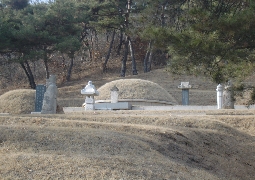
The cultural heritage, Shindobi, The tomb of Mr. Han Gye Mi
The tomb of Mr. Han Gye Mi is located in the graveyard of Chungju Han in the Simyogol village in Gwansandong and is a grave which has an altar and shrine. In the left side is the grave of Mrs. Yun.
There is a tombstone which was built in 1972 on the right side, and on the front middle of the burial mound there is a white marble tombstone which is seen to be built in those days.
The shindobi of Mr. Han Gye Mi is located in the entrance of the graveyard and was built in December of the 2nd year of Sungjong(1471) and has a cornerstone of the tombstone and a rectangle brace. The monument house was new built recently.
Hangyemi(1421~1471) is the government official of the early days of Joseon and the adult name is Gongbo, and lived in Chungju. He is the son of the governer(Gwanchalsa) Hye.
Mr. Hangyemi married the sister of Queen Junghee who was the wife of King Sejo, and in the 20th year of King Sejong(1438) he used Eumbo and became Pangwan in Naju and Hyungjodogwanjwarang afterwards.
He followed Suyangdaegun to Ming Dynasty as a Saeunsa in the 2nd year of Munjong(1452) and when Suyangdaegun became King Sejo in 1455 he became Jisaganwonsa by being 3rd place in the Jwaikgongshin and became Dongbuseungji, and Useungji and became a vice minister of the Hyungjo and Hojo. When there was a rise in revolt by Lee Si Ae, he took the picked troops and put in effort for peace and became a Jeokgyegongshin(3rd place) as a governor.
Later on he was Jwachanseong and the minister of interior at the same time and was rewarded Seowonbuwonjun in the first year of Seongjong(1470) and was written as Jwarigongshin in 2nd place and became Youngjuchungbusa.
Minmyeong
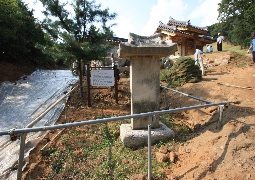
The tomb of Mr. Park Dae Rip
The tomb of Mr. Park Dae Rip is located in the south direction in Ogeumdong of Sangchon village in Tongillro Sutdolgogae graved together with the wife, Mrs. Hwang of Jangsu.
Shindobi that entered in 1692 in the 18th year of King Sukjong has a a roof of stone stupa and Unmun carved in the rectangle brace and Lee Jung Gu, Kwongyu and Kyunghu(the 5th descendant) wrote the writings.
Park Dae Rip(1512~1584) was the government official in the mid Choseon Dynasty and the adult name was Subaek, and the comfortable name was Muwidang, and lived in Hamyang and is the third son of Donryungbujeong.
He was the writer of TwegyeIhwang in the 35th year of Jungjong and was promoted to Byunggwa in the Siknyeonmungwa and later on became a professor in Yangju.
Afterwards he became Taesangchambong and when he was Hyungjojwaryang he protested an old lawsuit that was filed secretly and ended it and received the recommendation of Yeongeuijeong and became a Jipyeong.
Afterwards, he became Gwanchalsa in hamgyeongdo, Daesahun, Dongjigyeongyeonsa, Gaeseongbuyousu and he was promoted in the 12th year of Seonjo(1579) from Ijopansa to Hyeongjopansa and went through Ijo, Hojopanseo and became Uchanseong.
In the 15th year of Seonjo(1582) he was Paneuigeumbusa at the same time and was Pandoryeongbusa and was Uchansung again and became Jwachansung.
Minmyeong
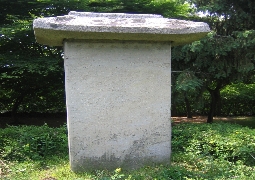
The handwritten Shindobi by Hanseokbong, The tomb of Mr. Park Se Young
The tomb of Mr. Park Se Young is located in the south direction in Ogeumdong over the Sutdolgogae in Tongilro and the burial mound is a Palgak tomb and is graved together with the tomb of the wife, Mrs. Kim from Gwangju.
On the left side of the tomb there is a Muinseok and on the right side there is a Muninseok which is unusual and 100 meters in front of the Shindobi is a rectangle brace and a Isu which an Unmun and a crane is carved in. This was built in the 15th year of King Seonjo(1582).
Park Se Young is the government official of the mid Joseon Dynasty and the adult name is GyeongI and he lived in Hamyang and is the father of Park Dae Rip who used to be Jwachanseong and Donryeongbujeong. Afterwards, he promoted to Sungjungdaebu Euijungbu Jwachansung because of his son's reputation.
Minmyeong
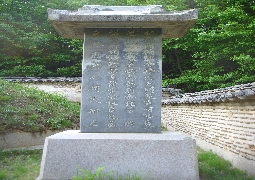
Tomb as a textbook in the late Joseon Dynasty, the tomb of Jusin Kim
Designation number: Regional cultural asset 18
location: 26-1 Daejadong Mountain, Deokyang-gu, Goyang-si, Gyeonggi-do
Jusin Kim was a father-in-law of Sukjong as a civil servant in the late Joseon Dynasty and also the father of the second queen of Sukjong, Inwon. His last name was Kim from Gyeongju. He was served in Gyeongreun Buwon-gun, and his other name was 孝簡公.
In 1686 (12th year of Sukjong), he passed Saenwonsi as a top candidate and served as Jangwonseobyulgum the next year and Guihuseobyulje in 1699 followed by Sahunbu officer and Hojojwarang. In addition, he was famous as a character serving his father, Iljin Kim, below his tomb in Youngsajeong. He was very filial and had a strong discipline, and his writings were known to contain serious meaning. His tomb was located about 200m behind Youngsajeong at Daeja-dong, Deokyang-gu, Goyang-si. Unlike the tombs in the early Joseon Dynasty, Gokjang was left from roof tiles behind circular burial mound. On the roof tiles and wall of Gokjang, there are flower patterns.
His tomb is well-preserved with original shape like the tombs of high rank officers or royal families of the king in the late Joseon Dynasty. First of all, there is a Bigalmyung to the right of the tomb. There are bullet marks. In front of the tomb, there is a Muninseok where grandiose and splendid patterns are enscribed. There is a Jangmyungdeong between two Muninseokgs. Behind Jangmyungdeung, there is a Honyuseok along with Hoseok so that soil and grass are not collapsed below the circular burial mounds.
In addition, there are epitaphs indicating the direction here and there around the Duleseok made in granite stone. To the west and south of Youngsajeong, there is a Sindobi of Jusin Kim. This has been designated as regional culture asset 18.
Minmyeong
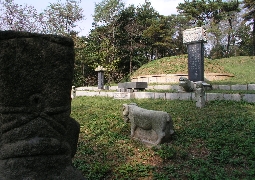
The tomb of Mr. Kijun
The tomb of Mr. Kijun is in the southwest direction behind the Sageunjul village in Sungsadong near the Hanyang culture club near the Wondang subway station and the burial mound is consisted of the grave of Mrs. Yun of Papyeong who is the wife of Mr. Kijun.
The tombstone which is written 'Bokjae Sunsaeng Kijun Ji MYo Wife Mrs. Yun sits' has been erected in April 1962.
Mr. Kijun(1492-1521) is a government official of the mid Choseon Dynasty and the adult name is Kyeong Jung and the comfortable name is Bokjae, Dukyang and he lived in Haengju.
He is the son of Eunggyo Gichan and the writer of Jogwangjo and he promoted to Byunggwa of the Byulsimungwa test in the 9the year of King Jung Jong(1541) and was an officer and became Chogyemunshin of Hongmungwan Jungja and did the Sagadokseo.
On the 11th year of Jung Jong he was Chunmun Yeseupgwan at the same time and after he was Gumtogwan, Suchan, Gumsang, Jangryeong, Siganggwan, he became eunggyo in 1519 and was banished to Onsung during the Kimyosahwa and went back to his hometown because his mother died and was strangled to death when he was banished again.
He received the posthumous conferment of honors as the minister of interior, and as one of Kimyomyunghyun there was a religious service in Chunggokseowon in Onsung, Asanseowon in Asan, Jonsanseowon in Jongseong, Munbongseowon in Goyang and his name after he died was Munmin.
Minmyeong
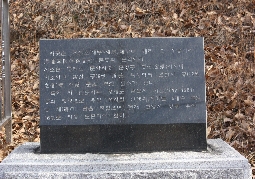
The tomb of Mr. Lee Ji Shin
The tomb of Leejishin is in the direction of Hyandongdeung in Yongdudong and is located in the southwest direction in the Hyanggol village in Hyangduro and there is one burial mound.
There is a tomb that seems to be built recently in the center of the tomb and 15 meters beneath the tombstone the Shindobi was built in the 3rd year of King HyungJong, and on the front side it is written, Igong Shin Do Bi JeungiJopanseo governor.
Lee Ji Shin(1512-1581) is a governement official in the mid Joseon Dynastry and the adult name is wonlip, the comfortable name is Bojindma and the place where they live is Ubong and he is the grandson of Lee Seung Gun and the son of Lee Sim.
Minmyeong
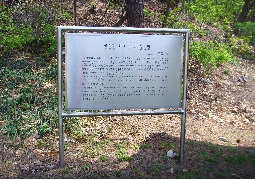
The beautiful carving method of shindobi, the tomb of Mr. Yoo YeoRim
The tomb of Mr. YooYeoRim is in the direction of south in the village of Dupodong which is located about 300 meters in Donhunro which is connected to the direction of Goyangdong town from Gajangdong threeway intersection. It is a twin grave with Mrs. Sung of Changryeong.
The tombstone was built in August in the 28th year of King Jungjong of the Chosun Dynasty and it is made with Osuk and built again in September 1935.
The marble Shindobi which is located 100 meters in front of the tombstone was built in the 19th year of King Sunjo(1586) has both Isu and Gidan.
Yoo Yeorim(1476~1538) is the general official of the mid Choseon dynasty and the adult name is Gye Ok, the comfortable name being called is Jeongdang, and lived in Gigye and the son of Gichang who is Chumji Jungchubusa.
Minmyeong

The tombstone of the then general during the Japanese Invasion of Korea in 1592, The tomb of Mr. Lee Shin Eui
The tomb of Lee Shin Eui is located in the foot of Doraeulsan in Doraeul village that is about 3km off the city hall of Goyang.
The tomb is a twin grave with the tomb of his wife, Mrs. Lee from Kyungju. The shindobi is located 50 meters in front of the tomb and on top of the front of each side it is written 'JeungIjopanseo Munjunggong Suktan Mr. Lee Shindobimyung' and the words were written by Uam Songsiyeol and and Yunyonggu posthumour honored and Kim Han did the Chujeon.
The scale of the roof of Stone Stupa is: height 160 centimeters, width 56 centimeters, and thickness 27cm.
Minmyeong
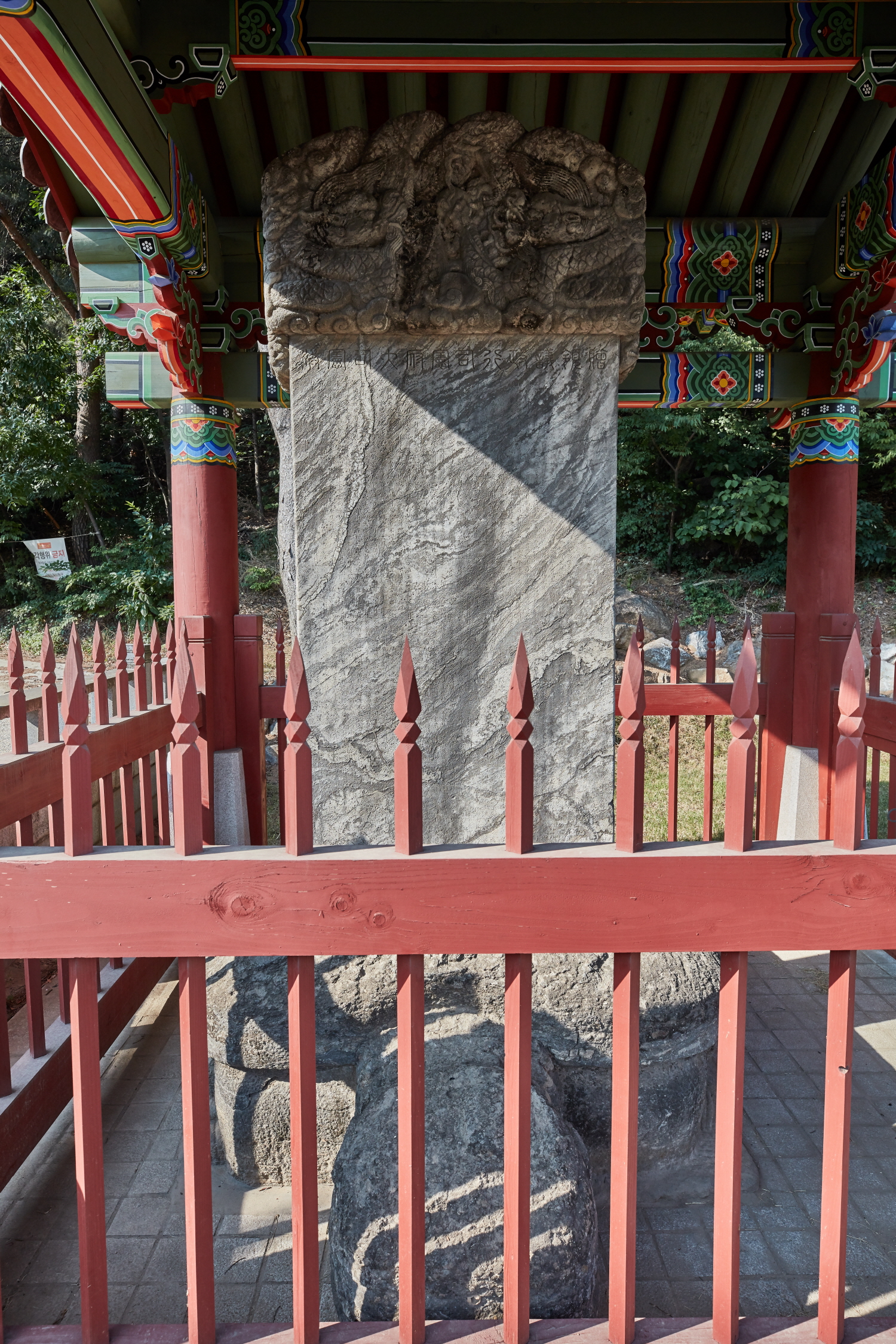
The tomb of Mr. Hong Yi Sang
Appointed Number : No.13 of Regional Cultural Assets
Location : Goyangsi Ilsandonggu Sungsukdong San 56-1
The tomb is located in the south direction in the side of Gobong Mountain in Sungsukdong.
It is a twin grave with the burial mound of the wife, Mrs. Kim from Andong, and the circumference is each 15 centimeters and the height is 240 centimeters.
There are Myobi, Sangsuk and Hyangrosuk in front of the cemetery and the Mangjuseok and Muninseok is placed on the left and right side.
In front of the burial mound there is the tombstone which Leejun built, the height is 170 centimeters, width 65 centimeters, and the thickness 25 centimeters.
The shindobi was built in the 8th year(1630) of King Injo and is standing about 150 centimeters beneath the cemetery.
The turtle base of the stone monument of the granite stone is well balanced but yet it is highly worned out and the carving of the Asu is delicate and distinct.
The words were made by Lee Jung Gu and written by Lee Hyun and carved in by Kim Sang Yong.
The scale of the marbled Bishin is : height 200 centimeters, width 115 centimeters, and thickness 29 centimeters.
HongYiSang is the government official of the Joseon era and was born in the 4rth year of reign of King Myungjong(in the year 1549) and died in the 7th year of reign of King Gwanghaegun(1615).
The first name is Insang and the adult name is Wonrae, or Gunsue.
He was called by the comfortable name Modang and lived in Pungsan and is the son of Sue.
He is the writer of Minsun of Haengchon, one of the people of Goyangpalhyun, and went through the 6 years of King Sunjo and after 6 years he was promoted as Gapgwa in the Siknyunmungwa.
He filled as Yejo, Hojo Hwarang, Parang, Jungun Suchan, Jijegyo and Byungjojungrang.
He was the Sagadokseo, Gyori, Jikjehak, Dongbuseungji and became YijochamEui.
On the 25th year of the reign of King Sunjo, when the Japanese invaded, he attended the King to Pyeongyang as a Yejochameui and became Byungjochameui.
In the year of 27th of the reign of Seonjo, he went on an official trip to Ming Dynasty as a Sungjeolsa and was the government post in Kyungsangdo as a Gwanchalsa, he contacted keenly with Bibyunsa and succeeded in the alienating measure among the enemies.
After the battle he became a Daesasung and refuted the appeal of excluding the wedding of Yusaeng Munkyungho of Youngnam and justified the marriage and was demoted to Andongbusa.
Afterwards he became the minister of Chungju and became the Daesahun on the year Gwanghaehun was ascended to the throne but felt sick and tired of the death in prison occuring from the fight between the factions and threw all his public officials away and died in Songdo.
His name after death is Munkyung and he has written the book [Modang Yugo].
He is one of the people of Goyangpalhyun who was religiously serviced in Munbongseowon in Goyang and the drawings of his life(1781 by Danwon Kimhongdo) is famous.
Minmyeong
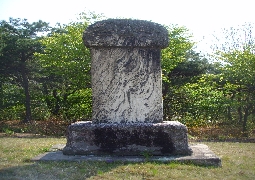
The cemetery which Dujeon of the Shindobi is unique, the tomb of Mr. Kimjeon
The tomb of Mr. Kimjeon is located 300 meters upward Wonheung station in Wonheungdong.
There is a record in the Sangsuk that it was newly built in the 10th year of the King Gwangmu's reign(1906).
The right side of the tomb and the Shindobi in the back side of the Mangjuseok is consisted of a granite Bijwa , Bishin and granite Isu and 'Kimchungjunggongshindobi' is carved clearly and especially the shape of the part of Bi's Isu is outstanding and the Isu of the Bi shows an excellent Shindobimun with a lively feeling of movement.
Kim jun is the government official of the early days of Joseon era and was born in the 4rth year of Sejo(1458) and died in the 18th year of King Jungjong's reign(1523).
His adult name is Jeungryun and his name called comfortably is Yeonan and he is the son of KimUshin who is the Jijungchubusa and becomes the great granfather of Kimjenam who is Yeonheungbuwongun.
In the 9th year of the reign of Jungjong(1514), he has went through Daesahun, Jwachansung and on the 13th year of King Jungjong's reign he wrote 'Sokdongmunsun' as the Chanjipchungdangsang to the King.
The next year he made the Kimyosahwa event as the Panjungchubusa and became Ueuijung and became Youngeuijung and Sejasa in the 15th year of Jungjong.
Minmyeong
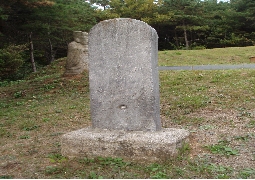
The cemetery which Mr. Yihwang made the epitaph, The tomb of Mr. Jungjiwoon
The tomb of Mr. Jungjiwoon is located in the southern side of Gobong Mountain behind Angok elementary school which the huge apartment complex is built. The tomb has a twin grave of the wife, Mrs. An of Chungju.
There are three tombs in front of the tomb together with Sangsuk, Hyangrosuk and Mangjuseok and a pair of Muninseok, and in the Myogal which was built in May of the 17th year of Myungjong has 'Chumangeusajungjiwoonjimyo' carved and the writings were praised by Twegye Yi Hwang and Songin wrote it.
Also the tombstone which was built in February in 1981 has osuk Bishin and granite Isu.
The place where Jungjiwoon(1509~1561) lived is Kyungju and his adult name was Jungi, and the name called comfortably was Chuman.
He was born in Goyang, Kyunggi province and learned Neo-confucianism under Kim an kook and Kim jung kook.
He wrote 'Chunmyung Doseol' and investigated harmony and later met YiHwang in 1553(the 8th year of King Myungjong's reign) and made some revisions, and afterwards this became the start of the Sachil dispute.
He was careful in relationships with others and was recommended to be in an official government but refused. In 1561, he went on a sightseeing to Chunma mountain and got sick and came back to Goyang and died and was canonized in Goyang.
Minmyeong
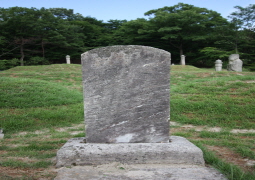
The tomb of Mr. Kim Myeong Won
The tomb of Mr. Kim Myeongwon is located in the direction of the west side in the tomb of Mr. Kim in Kyeongju in Gwansandong and has a twin grave of the wife, Mrs. Han of Chungju.
The Shindobi that is located 100 meters in front of the burial mound of the tomb was built in May of the 21st year of Sukjong and has a rectangle brace and roof of the stone stupa.
In the front of the tombstone it is carved 'Pyeongrangongshin Jwaeuijeong Gyungrimbuwongun Jeungsichungik Kimgongshindobimyeong' and Lee jung gu made the words and Kim Jong Youn wrote it and Kim Chang Hyup sent the word.
Kim Myeong Won(15341602) is the government official of the mid Joseon Dynasty and his adult name is Eungsun, his name called comfortably is Jueun and he lived in Kyungju and is the son of Kim Man gyun who is the governor(Gwanchalsa).
He was the writer of Twegye Yihwang and passed the Samasi test in the 13th year of King Myungjong(1588) and was promoted to Gapgwa in Siknyunmungwa.
He filled the government post inside and out such as the Jongsungbusa in the 2nd year of King Sunjo(1569) and was also Jieuigeumbusa as a Jwachamchan in the 20th year of King Sunjo(1587).
He made a contribution in resolving the rebellion incident of Jungyeorip and rised to the 3rd place of Pyeongnangongshin as was rewarded as the Gyungrimgun, and filled the Jwachansung, Yijopanseo, Ueuijeong and etc and was risen to the Jwaeuijeong while being rewarded as Buwongun in the 33rd year of King Sunjo(1600).
Kim Myeongwon had profound knowledge in overseas studies and was proficient in Byungseo, Gungma.
Minmyeong











